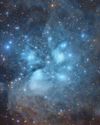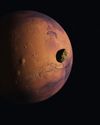
Astronomers have discovered new evidence that Andromeda, the galaxy next door to our own, grew by merging with another galaxy. The event triggered a mass migration of stars into the galaxy. This event suggests that the migration of stars to Andromeda – also known as Messier 31 – and the galaxy’s growth history is very similar to that of the Milky Way. That means the findings have implications for our understanding of both galaxies. The evidence came in the form of observations of the individual motions of almost 7,500 stars in the inner halo of Andromeda, showing these stars had begun their lives as part of another galaxy that merged with Andromeda around 2 billion years ago.
Scientists have long predicted that large galaxies have grown to their current sizes via collisions and mergers throughout their history, but the patterns in the motions of stars that could confirm this have been elusive. The investigation was conducted by an international team of astronomers using the Dark Energy Spectroscopic Instrument (DESI) on the Nicholas U. Mayall Telescope at Kitt Peak National Observatory, operated by the National Optical-Infrared Astronomy Research Laboratory (NOIRLab). “Our new observations of the Milky Way’s nearest large galactic neighbour, the Andromeda Galaxy, reveal evidence of a galactic immigration event in exquisite detail,” lead researcher and NOIRLab astronomer Arjun Dey, said. “Although the night sky may seem unchanging, the universe is a dynamic place. Galaxies like Messier 31 and our Milky Way are constructed from the building blocks of many smaller galaxies over cosmic history. “
Diese Geschichte stammt aus der Issue 141-Ausgabe von All About Space UK.
Starten Sie Ihre 7-tägige kostenlose Testversion von Magzter GOLD, um auf Tausende kuratierte Premium-Storys sowie über 8.000 Zeitschriften und Zeitungen zuzugreifen.
Bereits Abonnent ? Anmelden
Diese Geschichte stammt aus der Issue 141-Ausgabe von All About Space UK.
Starten Sie Ihre 7-tägige kostenlose Testversion von Magzter GOLD, um auf Tausende kuratierte Premium-Storys sowie über 8.000 Zeitschriften und Zeitungen zuzugreifen.
Bereits Abonnent? Anmelden

MYSTERIES OF THE UNI WHERE ARE ALL THE SPIRAL GALAXIES?
There are far fewer spiral galaxies than elliptical ones in the Supergalactic Plane, and scientists are keen to discover why

ZOMBIE STARS
+10 OTHER TERRIFYING SPACE OBJECTS

HOW TO BEAT LIGHT POLLUTION
Thought it was impossible to observe the wonders of the night sky from towns and cities? Think again. Follow our tips and tricks on successfully observing through sky glow

15 STUNNING STAR CLUSTERS
These beautiful stellar groupings are spattered across the cosmos

Eileen Collins "It was a difficult mission...we were the first to see Mir"
Having served as both the first female pilot and first female commander of NASA's Space Shuttle, Collins boosted the involvement of women in space exploration to a whole new level

MARS LEAKS FASTER WHEN IT'S CLOSER TO THE SUN
The Red Planet has lost enough water to space to form a global ocean hundreds of kilometres deep

FUTURE TECH KANKOH-MARU
This ambitious reusable spacecraft will be capable of taking 50 people to and from orbit

THE FINAL FRONTIER
Beyond the reach of the Sun is a fascinating region of the cosmos that were only just beginning to explore

A long-lost moon could explain Mars' weird shape and extreme terrain
A long-lost moon could explain why Mars is so different from the other rocky planets in the Solar System. Today Mars has two tiny moons.

A sprinkling of cosmic dust may have helped kick-start life on Earth
Cosmic dust may have helped kick-start life on Earth. New findings challenge a widely held assumption that this wasn't a plausible explanation.